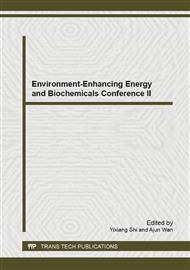[1]
Bhagat, K. C., Singh W. Some observations on the biology & behaviour of Carmine spider mite Tetranychus cinnabarinus (Boisduval) (Acarina: Terranychitae): A pest of brinjal vegetable,J. Advan. Zool., 1999, (20), pp.28-31.
DOI: 10.1303/aez.22.499
Google Scholar
[2]
Kuang H. Y. Tetayanychus viennensis, in Forest Insects of China, 2nd ed. G. R. Xiao, Ed. Beijing: China Forestry Press, 1992, pp.1290-1292.
Google Scholar
[3]
Hazan, A., Gerson, U., Tahori, A.S. Spider mite webbing. I. The production of Webbing under various environmental conditions. Acarologia16, 1974, p.68–84.
Google Scholar
[4]
Bulut,E., Göc¸men,H. Pests and their natural enemies on greenhouse vegetables in Antalya. Integrated control inprotected crops Mediterranean climate. IOBC. Wprs. Bull. 2000, 23, pp.33-37.
Google Scholar
[5]
Dagli,F., Tunc,I. Dicofol resistance in Tetranychus cinnabarinus: resistance and stability of resistance in populations from Antalya, Turkey. Pest. Manag. Sci. 2001, 57, pp.609-614.
DOI: 10.1002/ps.334
Google Scholar
[6]
Ambikadevi,D., Samarjit,R. Chemical control of red spider mite Tetranychus cinnabarinus (Boisduval) on okra. J. Trop. Agric. 1997, 35, p.38–40.
Google Scholar
[7]
Liu, G. Q, Gao, J. M., Wu, W. J. Recent advances in natural insecticidal constituents from plant origin. Acta Bot. Borea1. -Occident. Sin. 2002, 22(3), pp.703-713.
Google Scholar
[8]
Zhu Y.P. Chinese Materia Medica Chemistry, PharMacology and Applications. Harwood Academic Publishers, Netherlands, 1998, p.519–520.
Google Scholar
[9]
Chinese Drugs Encyclopedia. Editing Committee of Chinese Drugs Encyclopedia. Sangmu Publishing, Hongkong, 1978, 938.
Google Scholar
[10]
Shi G.L., S.Q. Liu, H. Cao, L.L. Zhao, J. LI, S.Y. Li. Acaricidal activities of Stellen chamaejasme against Tetranychus viennensis (Acari: Tetranychidae). Journal of Economic Entomology, 2004, 97(6), p.1912-(1916).
DOI: 10.1093/jee/97.6.1912
Google Scholar
[11]
Jin, S.X., Z.F. Gu., G.H. Dai., X., B. Chen. Study on Inhibition Effects of Plant Extracts against Cucumber Powdery Mildew. Journal of Shanghai Jiaotong University (Agricultural Science). 2006, 24(1), pp.48-53.
Google Scholar
[12]
Wang N. J. , Liu J. J. , Ling Z. Z. , and Lai Y. F. A preliminary study on Wisktoemia chamaedaphne and its toxicity in caijiachuan river basin, Shaanxi Province, Shanxi For. Sci. and Tech., 2002, (3), pp.1-5.
Google Scholar
[13]
Shi G. L. , Zhao L. L. , Liu S. Q. , Cao H. , Clarke S. R., andSun J. H. ,. Acaricidal activities of extracts of Kochia scoparia against Tetranychus urticae, Tetranychus cinnabarinus and Tetranychus viennensis (Acari: Tetranychidae), J. Econ. Entomol. , 2006, (99), pp.858-863.
DOI: 10.1093/jee/99.3.858
Google Scholar
[14]
Wang, M. T., Xie, P. S., Wang, Z. D. The Extraction, Isolation and Structural Identification of Natural organic compounds. Beijing: Chemical Industry Press. (2004).
Google Scholar
[15]
SPSS Inc., SPSS Base 10. 0 User's Guide. Chicago, IL: SPSS, (1999).
Google Scholar
[16]
Mansour F., Azaizeh H., Saad B., Tadmor Y., Abo-Moch F., Said O. The Potential of Middle Eastern Flora as a Source of New Safe Bio-Acaricides to Control Tetranychus cinnabarinus, the Carmine Spider Mite. ENTOMOLOGY, 2004, 32(1), pp.66-72.
DOI: 10.1007/bf02980862
Google Scholar
[17]
Wang Y. N. , Shi G. L. , Zhao L. L. , Liu S. Q. , Yu T. Q. , Clarke S. R. Acaricidal activity of Juglans regia leaf extracts on Tetranychus viennensis and Tetranychus cinnabarinus (Acari: Tetranychidae), J. Econ. Entomol., 2007, (100), pp.1298-1303.
DOI: 10.1093/jee/100.4.1298
Google Scholar
[18]
Feng G., Zhang J., Bai J., Peng Z.Q. Isolation and Identification of Acaricidal Composition of Thymus mongolicus. Acta Bot.Boreal.-Occident. Sin, 2009, 29(9), pp.1893-1897.
Google Scholar
[19]
Zhao J., Dai G.H., Gu Z.F., Chen X.B., Sun X.Q. Preventive Effect of 20 Plant Extracts against Cucumber Downy Mildew, journal of Shanghai jiaotong university (agricultural, science), 2005, 23(3), pp.308-311.
Google Scholar
[20]
Yang X. J., He Y.X., Ru X.S., Chen F.R., Ru T. Inhibition and nematocidal effect of plant extracts on Meloidogyne incognita. Fujian Journal of Agricultural Sciences, 2004, 19(2), pp.78-81.
Google Scholar


